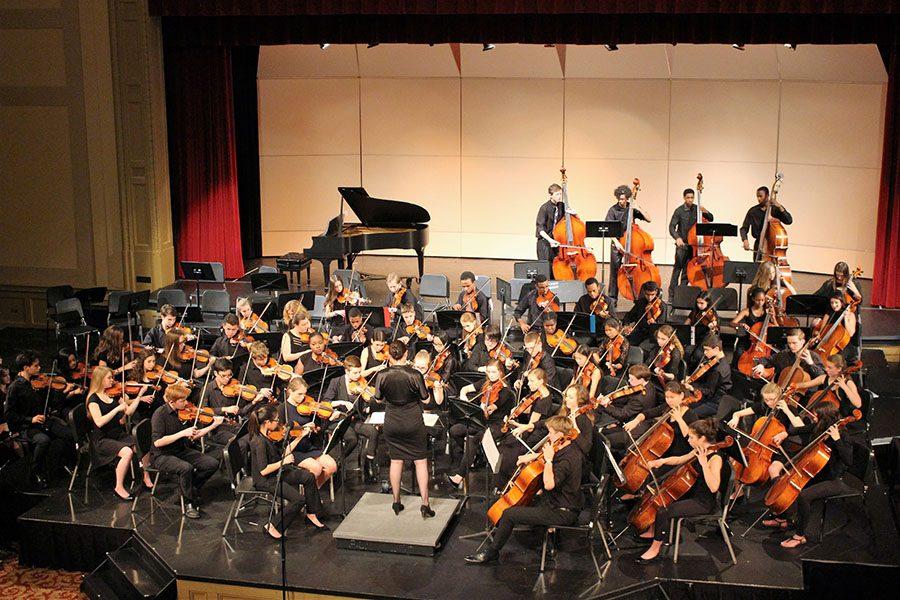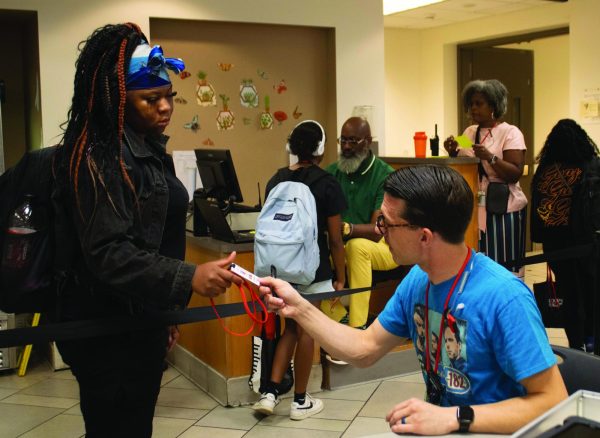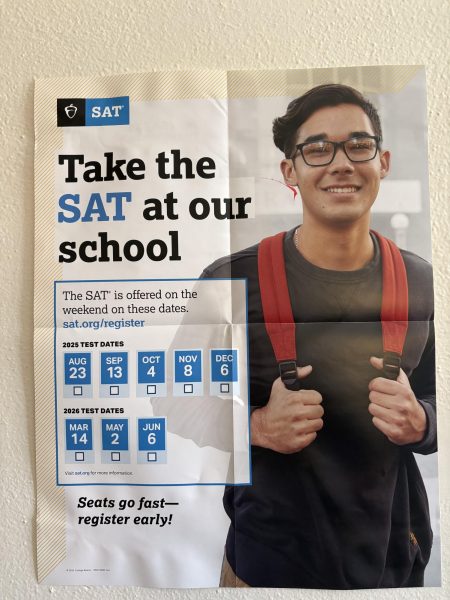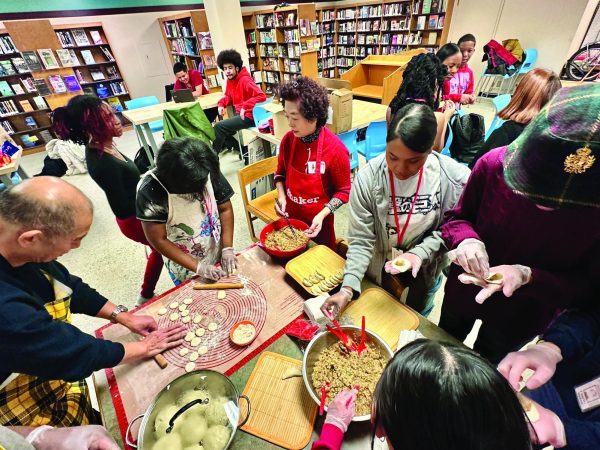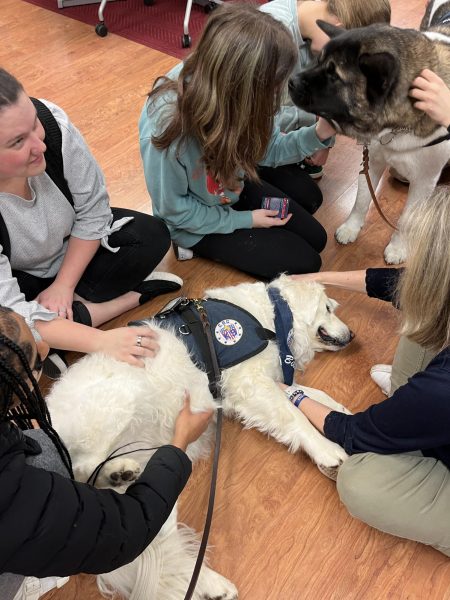Orchestra’s Strength is Challenged by Their Numbers
Two orchestra groups — string and chamber — demonstrate a wide variety of advanced skills, although their numbers may affect their strength in years to come
The Chamber Orchestra plays at their spring concert April 25.
There is strength in numbers.
The high school’s two orchestras — 136 musicians comprising string and chamber groups — performed their spring concert in the large auditorium April 25 at 7:30 p.m.
The String Orchestra features 78 members who play violin, viola, cello and bass. The Chamber Orchestra, the class that plays more advanced music, features 58 members who play the string instruments with the addition of one harpist.
The students had “only a couple months” to prepare for their last concert of the school year, said orchestra teacher Donna Jelen. “We had contest in February, and then after that, we started for the spring concert. So, maybe just over two months.”
Every year, the Ohio Music Education Association holds a statewide Orchestra Contest in which orchestras across Ohio perform for professional judges, Jelen wrote in an email. “The judges rate each orchestra on their performance using a five-point scale where one is the best. Each orchestra performs three prepared pieces and then sight-reads one piece. They have no opportunity to rehearse or practice the sight-reading piece. They just have a few minutes to look it over and then one chance to play it as a group for a rating,” Jelen wrote.
“This year, every orchestra student at Shaker competed in the Class A division, which is the most rigorous level with the most difficult music. It is highly unusual for a school to send all of its students Class A. Both orchestras performed well and received good ratings, three or better, and the Chamber Orchestra received a one, superior, rating from every single judge.”
At the spring concert, the String Orchestra performed six pieces ranging from classical to pop songs. First, they played “Game of Thrones” composed by Ramin Djawadi. Then, “Persephone’s Revenge” composed by Jeffrey Bishop. Then came their first pop song, John Legend’s “All of Me”, composed by John Stephens and Toby Gad. Next came “The Chase”, composed by David Shaffer, followed by their second pop song, Adele’s “Rolling in the Deep”, composed by Paul Epworth. For the String Orchestra’s finale, they performed “New World Symphony” composed by Antonin Dvorak.
The Chamber Orchestra, on the hand, stuck to classical pieces. They began with “Serenade No. 1”, composed by Robert Fuchs. Then, “Sinfonia for Strings” composed by Alexander Borodin. They finished with a piece composed by John Williams, “March of the Resistance.”
According to Jelen, each piece serves as a tool for orchestra students to improve their skills. “I try to pick a variety of pieces so that I cover fast and slow, you know, happy, sad, all that,” she said. “For string orchestra, I try to make sure to pick pieces that have a variety of techniques and some techniques that push them.”
Jelen’s choices of pieces reflect the feedback students received from OMEA judges. “For String Orchestra, they had pieces with more flats than they were maybe used to and some tricky bowings, and I also made them shift.” String musicians shift when they move their fingers along the neck of their instruments to create diverse notes. “I made all of them shift in most of the songs because in contest, that was one of our pieces of feedback that we got from the judges, is that we need to use more advanced fingerings instead of just doing everything in first position.” In first position, the musician’s fingers are closest to the tuning pegs.
“The most difficult part of the concert was probably bowings and intonation,” String Orchestra violinist Monet Bouie, a freshman, said. “Especially for our three big pieces, Persephone’s Revenge, The Chase and New World Symphony.”
“For chamber, I picked the Borodin because we have a very lovely cello [section]. The piece features the cello section a lot and I wanted to showcase them a little bit and it’s also a really well-balanced piece. All the instruments have interesting parts, which is important. I always try to pick stuff where, you know, it’s interesting for everyone. Even the parts that are sometimes less active like second violin [and] bass. I want to make sure the pieces have stuff for all the students to work on and get interested in.”
Over the course of the year, between their three seasonal concerts, the students find their skills and confidence improving. “With strings, I feel we improved our sight reading and our confidence, especially when we went to competition,” Bouie said. “When we went to competition, we chose to do Class A instead of Class B. I feel like our confidence has kind of increased because at first you’d feel like you have this big gap between chamber and strings but I feel like our confidence has increased.”
“I always try to push them more and more as the year goes on. So, every concert, the music kind of gets a little harder,” Jelen said. “So they are mastering harder music. But also, particularly in String Orchestra, the improvement has been ridiculous. They’ve gone from playing sort of at a basic level to really doing some advanced stuff. So, I’m able to choose things for them now that I wouldn’t have dreamed that I could choose for them at the beginning of the year. I think contest was a big part of that. It really pushed them. And I credit them with that because I would have maybe played it safe and gone with Class B, which is a little easier, but the students wanted to go with Class A. So, I said ‘Okay!’.”
Before the final piece, Jelen hosted a small recognition ceremony in which all the graduating seniors in the orchestra got an award. “It was the best concert this year,” Bouie said. “but I don’t feel really bad about it because I’m a freshman and I have a lot more years to come. But I can see how it could be emotional for some players who are seniors.”
Chamber Orchestra viola player George Woods, a senior, received the award for most improved student. “I feel happy. I feel proud,” he said. “I almost cried. I almost teared up and Ms. Jelen, she started to tear up, too. It was kind of unexpected.” Woods plans to continue playing the viola in college.
Most orchestra students agreed the event went well. “I think we actually did really good,” Bouie said. “I feel it summed up all the hard work we’ve been doing all year.”
“I think we played well. The String Orchestra and the Chamber Orchestra did pretty well. We were really in sync. I think it was good,” Woods said. “I think the best part is that we all played together and pretty powerfully.”
“I thought it was great,” Jelen said. “There’s always stuff that you want to go back and kind of fix but I thought it was really good.”
The main goal for Bouie in the next year is to continue playing challenging pieces.“For next year, I hope to do competition again and do a lot more Class A songs,” she said.
For the orchestra as a whole, the hope is to keep their number of members as large as it is this year. “I hope that our numbers remain good,” Jelen said. “We are up against a scheduling challenge at the middle school because the middle school students are choosing, now, between art and music and it has really hit our numbers hard. If that doesn’t change, I’m afraid that the orchestra in four years will be half the size that it is now.”
Due to the middle school’s change from nine 39-minute periods to eight 50-minute periods, there is no longer space in the students’ schedules for a music class.
“I think the program has really improved, the more people we’ve been able to assemble because there is something about numbers that is very motivating for students,” said Jelen. “It creates a lot of good, I don’t want to say competition, but leadership. You know, when you have more students, there are more opportunities for leadership. So, I’d hate to lose that. We did OK when we were half this size but it’s nothing like it is now. I’d like to keep this. I really would.”

